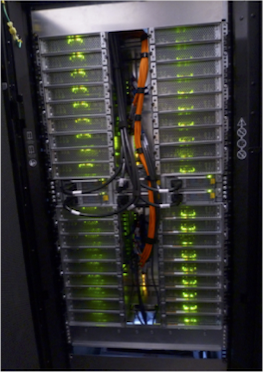You are here : en > Science for all
Interview #6 : A supercomputer for modeling the formation of the first galaxies
Interview of Léo Michel DANSAC, CRAL, Scientific Calculation Department
Interview of Dario AUTIERO, Researcher, IN2P3

A supercomputer is a computer with exceptional computing power. It consists of a very large number of processors (from several hundred to several tens of thousands) governed by the same operating system. The combined power of these compute blades is measured in petaflops, that is to say in millions of billions of operations per second. The world's most powerful supercomputer delivers 200 petaflops!
Typically, supercomputers are designed specifically for one type of task, most often complex scientific calculations. These types of intensive computing devices are used both in research and in industry to, for example, design new, innovative, products or to simulate and understand complex physical phenomena (climates, meteorological phenomena, earthquakes, the creation of stars and galaxies, etc.)
For which project does CRAL use the CCF?
The Common Computing Facility (CCF) is the supercomputer acquired by the LabEX ‘Laboratory of EXcellence’ at the Lyon Institute of Origins (LIO) in 2014. It has 1,300 processors and a power of 30 teraflops. It serves as a calculating facility for several LIO teams and, in particular, a team of scientists from the Center for Astrophysical Research in Lyon (Centre de Recherche Astrophysique de Lyon (CRAL)) working on the international Sphinx project, the goal of which is to understand the formation of the first stars and galaxies, using and developing the common RAMSES simulation software.
Shining a spotlight on the beginnings of the universe
Sphinx's specific aim is to understand the processes at work during the "Epoch of Reionization", a little understood period in the early history of the universe, during which its contents experienced a dramatic change. Digital simulation is an essential tool for understanding this kind of very old phenomenon. It serves to compensate for observational limitations, because all we can see from Earth today of the primordial galaxies is necessarily extremely distant. The light we receive from them must have left them more than 12 billion years ago!
Thanks to the CCF, scientists based at the CRAL are trying to identify, understand and reproduce, using multiple simulations, the physical processes at work, so as to explain the properties of galaxies as observed by astronomers. The complexity and diversity of the physical processes involved (the dynamics of billions of celestial bodies, the mechanics of multi-scale fluids, etc.) require the use of these specialized computers